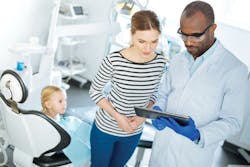In the ever-evolving world of digital dentistry, it can be easy to find ourselves on an endless march, advancing the technological baselines of our practices. From new intraoral scanners and milling machines to front-end programs such as digital check-in services and tablets for health forms, each new dental technology provides a tangible benefit to our workflows and patient care. It is important, however, to recognize the difference in perspectives between the practitioner and the patient.
To us, adopting these new technologies can be a never-ending, fever-pitched race to stay on the cutting edge. Dentistry is advancing at an astounding rate. As dentists, we spend the majority of our week surrounded by those changes. We see new patients, read dental articles, talk to our reps, interact with our labs, communicate with other dentists, and attend conferences, always adapting to the changing tides of the field and learning of new technologies as quickly as they come out—or even months before. This twists our perspective on how radical these changes can be.
For a dentist who sees the entire process from start to finish, adopting a new technology is a long, thought-out affair with both our patients and our businesses in mind. We see everything through from conception to purchase to implementation—for us, it covers the span of months, if not years. Meanwhile, to patients, the new technology simply appears.
© Dmytro Zinkevych - Dreamstime.com
New technology can be surprising or even intimidating for some of our patients. Entire aspects of their dental routines can change between visits. It falls on us to introduce the new technology and communicate about it in a way that promotes confidence in its benefits. We have to find a way to express the weight of the technology’s adoption without having to explain its intricacies outright. This can be a challenge, particularly for patients who have an aversion to technology. Others readily accept changes and even enjoy them, being apt in technology themselves. Each patient’s personality type will determine the approach you use to explain the new technology.
Technology-apt patients
Explain the technology: Explain the basic premise of the technology. In the case of chairside technologies such as intraoral scanners, briefly showing the patient how they work can pique their interest. Some may even be excited about their use.
Enthusiasm: Enthusiasm should be met with enthusiasm. Patients who show an interest in technology generally find comfort in it and may even equate it with safety and professionalism. Meeting that enthusiasm can put patients at ease and bolster their confidence in the practice. This can be powerful when it comes to word-of-mouth referrals and online reviews.
Neutrality: Many patients meet technology with general neutrality. In such cases, it is usually best to make minimal mention of it, allowing the technology to become a seamless aspect of their dental visit and simply a part of general operations.
Continuing engagement: In some cases, such as with in-house CAD/CAM milling and same-day restorations, patients may show an interest in the entire process. This should be encouraged. Allowing patients to see a crown in a milling unit or sending them a screenshot by email of a digitally designed tooth can be powerful tools to encourage patients’ continuing comfort and interest in oral health.
Technology-averse patients
Explain the technology: Explain the basic premise of the technology. Patients who are averse to technology may have reservations about its use.
Reservations: In some cases, patients may question the need for the technology or have dissatisfaction with the change. It is important to meet these worries with patience and care. As dentists, we are responsible for our patients’ health, and these technologies allow us to provide better care. That should always be the focus of your response. Avoid comparisons to outside technologies whenever possible; this will maintain the medical relevancy of the technology and eliminate the possibility of comparisons to issues patients may have outside the practice.
Questions: Many technology-averse patients have questions—often persistent—about the technology and its use. Handle these questions with patience and care. Answering questions, regardless of the frequency, is pivotal to your patients’ comfort. Unlike the technology-apt, these patients find new equipment uncomfortable and/or intimidating. Answering their questions can help assure them of the new technology’s benefits.
Traditional methods: In the worst-case scenario, when a patient shows real discomfort with the technology, be ready to rely on traditional methods. In the case of impressions, always keep a stockpile of traditional materials, even if your practice is attempting to become entirely digital. This will give you an option to keep every patient comfortable.
Every patient, practice, and practitioner is different. But keeping all of these different perspectives in mind can help us comfort our patients and introduce them to our ever-changing technologies. As dentistry advances, these changes may occur more frequently, and patients may encounter brand-new techniques and technologies with every other visit. Mastering the introduction of these advancements is pivotal to the modern dental practice.







